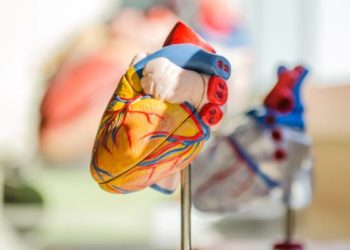Smartphone volunteer app dispatches may increase Automated External Defibrillator use
1. In patients experiencing an out-of-hospital cardiac arrest, there was a small, but not statistically significant increase in the proportion of patients who had an automated external defibrillator (AED) attached prior to emergency medical services (EMS) arrival in volunteer responders who were instructed to fetch the nearest AED and volunteer responders who were instructed only to initiate CPR.
Evidence Rating Level: 1 (Excellent)
Study Rundown: Survival following an out-of-hospital cardiac arrest is highly dependent on prompt cardiopulmonary resuscitation (CPR) and defibrillation; previous research has suggested that if CPR and defibrillation are initiated within minutes following cardiac arrest, most patients can be saved. Thus, current low bystander CPR and defibrillation rates are major obstacles to increased survival rates. A previous study has shown that a system for mobile dispatch of volunteer responders to out-of-hospital cardiac arrests increased overall bystander CPR rates. This system has been merged with registries containing publicly available automated external defibrillators (AED), and is recommended in international resuscitation guidelines, but has not yet been evaluated in a randomized clinical trial. This is a community-based trial that took place in the Swedish regions of Stockholm and Vastra between December 2018 and January 2021. This study used a smartphone application, Heartrunner, which was a mobile phone positioning system for the dispatch of CPR-trained volunteer responders to nearby out-of-hospital cardiac arrests. When there was a suspected out-of-hospital cardiac arrest, the system located a maximum of 30 volunteers within a 1.3 km radius of the event, at which point they would accept or decline to help. Cases eligible for inclusion were emergency calls presenting as suspected out-of-hospital cardiac arrests between 7 A.M. and 11 P.M. In the intervention group, 4 of 5 responders that accepted were tasked with collecting the nearest AED prior to the patient, while 1 of 5 responders was instructed to go directly to the patient to initiate CPR. In the control group, all responders were instructed to go directly to the patient to perform CPR. Randomization was computerized and integrated into the volunteer responder system server. The primary outcome of interest was bystander-attached AED, including other volunteers not using the application before the arrival of emergency medical services (EMS) or on-duty first responders (fire and police services). Overall, 947 patients with out-of-hospital cardiac arrests were included in the final analysis, with 48.7% (n = 461) allocated to the intervention group. With respect to the primary outcome, 13.2% of patients (n = 46) had an AED attached by a bystander before EMS or first responder arrival in the intervention group compared with 9.5% of patients (n = 61) in the control group (difference, 3.8% [95% CI, -0.3% to 7.9%]; P=.08). Between the intervention and control group, there were no significant differences in bystander CPR or defibrillation before the arrival of EMS. Overall, a difference of nearly 4% was observed in the primary outcome in favour of the intervention group, though this difference was not statistically significant. The reason for this may be the result of many AEDs placed by volunteers that were not volunteer responders, as well as crossover and low compliance with the instructions by the volunteer responders. However, these findings display overall that the volunteer responder system contributes to an increase overall in the use of AEDs and bystander CPR and are an important addition to existing first responder services.
Click to read the study in JAMA Cardiology
Relevant Reading: Mobile-Phone Dispatch of Laypersons for CPR in Out-of-Hospital Cardiac Arrest
In-Depth [randomized controlled trial]: This study analyzed the relationship of instructions within a mobile smartphone application for fetching the nearest AED with the primary outcome of bystander-attached AED prior to EMS and first responder arrival. Included were emergency calls presenting as suspected out-of-hospital cardiac arrest between 7 A.M. and 11 P.M. where the volunteer responder system was activated. Pre-randomization ineligibility criteria included out-of-hospital cardiac arrest due to trauma or suicide and in children (age ≤8) and in hazardous environments. Post-randomization, exclusion criteria included patients without out-of-hospital cardiac arrest, patients not treated by EMS, and patients with a cardiac arrest witnessed by EMS. Cases were randomized to the intervention group, where volunteers received instructions to fetch the nearest AED, and the control group, where all volunteers were instructed to initiate CPR with no mention of AED location. 947 patients with out-of-hospital cardiac arrests were included in the final analysis, with 461 cases in the intervention group. 13.2% of patients (n = 46) had an AED attached by a bystander before EMS or first responder arrival in the intervention group compared with 9.5% of patients (n = 61) in the control group (difference, 3.8% [95% CI, -0.3% to 7.9%]; P=.08). Interestingly, the majority of AEDs were attached by volunteers who were not volunteer responders (37 in the intervention arm, 28 in the control arm). The proportion of bystander CPR being initiated prior to EMS arrival was 68% (n=318) in the intervention arm and 71.6% (n=348) in the control arm (P=.42). The proportion of patients who received defibrillation before EMS arrival was 3.7% (n=17) in the intervention arm versus 3.9% (n=19) in the control group (P=.99). Overall, the findings from this study do not suggest a statistically significant difference in bystander AED attachment in patients where volunteer responders were instructed to fetch an AED, and in patients where volunteer responders were only instructed to initiate CPR.
Image: PD
©2022 2 Minute Medicine, Inc. All rights reserved. No works may be reproduced without expressed written consent from 2 Minute Medicine, Inc. Inquire about licensing here. No article should be construed as medical advice and is not intended as such by the authors or by 2 Minute Medicine, Inc.







